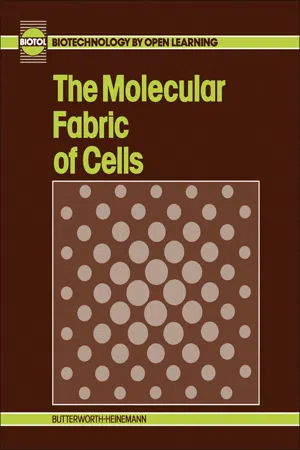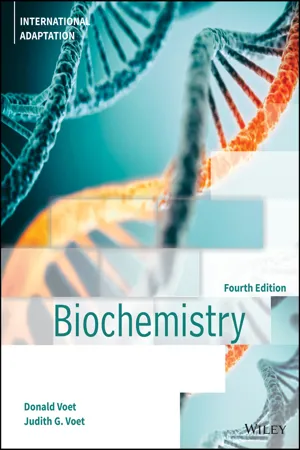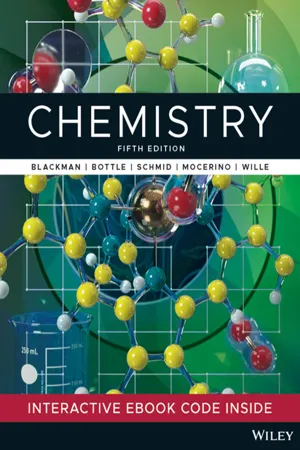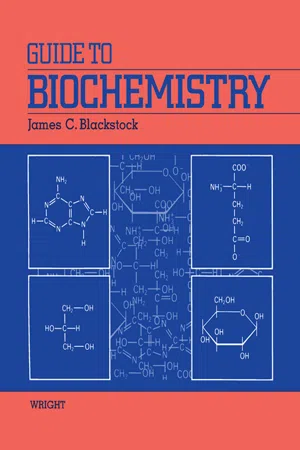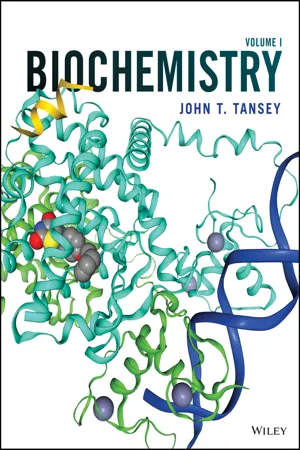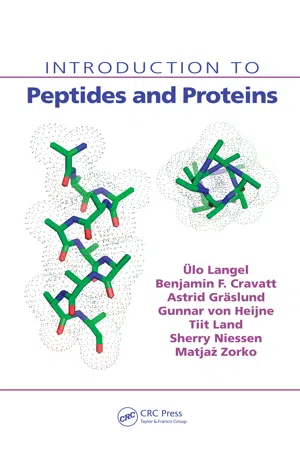Chemistry
Amino Acid Groups
Amino acids are classified into different groups based on the properties of their side chains. The main groups include nonpolar, polar uncharged, acidic, and basic amino acids. Nonpolar amino acids have hydrophobic side chains, while polar uncharged amino acids have hydrophilic side chains. Acidic amino acids have a negative charge at physiological pH, and basic amino acids have a positive charge.
Written by Perlego with AI-assistance
Related key terms
1 of 5
10 Key excerpts on "Amino Acid Groups"
- eBook - PDF
Polysaccharides Peptides and Proteins
Pharmaceutical Monographs
- R. T. Coutts, G. A. Smail, J. B. Stenlake(Authors)
- 2014(Publication Date)
- Butterworth-Heinemann(Publisher)
To the organic chemist an amino acid refers to any molecule possessing both an amino and an acid group. The bio-chemist, on the other hand, tends to reserve the term for those compounds in which an amino group occurs on the same carbon atom as a carboxyl group—α-amino acids (I)—and which have largely been isolated from protein hydrolysates. H H I I R—C—COOH R—C—COO~ I I NH 2 NH 3 (I) + da) 80 AMINO ACIDS The side group (R in I) in most cases is neutral and thus the amino acid is neutral since under most conditions it is the salt-like dipolarionic form (la) which is favoured. A few amino acids con-tain a second acidic or basic function in the side-chain and the molecule as a whole then departs from neutrality. Table 2 illus-trates the common amino acids of which proteins are largely com-posed, whereas Table 3 shows amino acids which are of less com-mon occurrence and are not all derived from proteins. In general the salt-like nature of the amino acids confers on them characteris-tic non-volatility, classical insolubility in organic solvents and high indefinite melting points which are almost invariably accom-panied by decomposition. The condensation of the amino group of one amino acid with the carboxyl group of another and the elimination of water results in the formation of a peptide linkage (—CONH—). Two or more amino acids joined by this linkage represents a peptide, and the prefixes di-, tri-, tetra-, etc. indicate the number of constituent amino acids. The term oligo-peptide is sometimes used to refer generally to these smaller peptides. The term polypeptide can be used to designate all but the simplest peptides. The proteins con-stitute the largest group of anhydrocopolymers of amino acids. An arbitrary distinction is usually drawn between polypeptides and proteins on a basis of molecular weight. The term polypeptide is usually reserved for those molecules whose molecular weight is less than 10,000. - eBook - PDF
Chemistry
An Industry-Based Introduction with CD-ROM
- John Kenkel, Paul B. Kelter, David S. Hage(Authors)
- 2000(Publication Date)
- CRC Press(Publisher)
As we will see later, these tasks include such duties as transporting specific chemicals throughout the body, helping certain chemical reactions to occur within the body, fighting off invasion by foreign organisms, and sending chemical messages from one part of the body to another. 17.2.1 Amino Acids In order to understand how proteins and peptides work, we first must look at their chemical structure. Proteins and peptides are made up of chains of amino acids . The basic structure of an amino acid is shown in Fig. 17.1. An amino acid always contains four types of functional groups that are connected to a central carbon atom. One of these groups is a hydrogen atom. Two of the other groups are a carboxylic acid and an amine group. It is the presence of these last two particular groups that gives rise to the name “amino acid.” The general structure and properties of both carboxylic acids and amine groups were discussed earlier 440 Chemistry: An Industry-Based Introduction with CD-ROM in Sections 6.7.5 and 6.8.1 of Chapter 6. The hydrogen atom, amine group, and carboxylic acid group are present in all amino acids. It is these three groups that give all of the amino acids a set of common properties. For example, as we will see in Fig. 17.3, the presence of both an amine group and a carboxylic acid group in all amino acids is what makes it possible to connect amino acids together to form proteins and peptides. The fourth type of group that is attached to the central carbon of an amino acid is different from one type of amino acid to the next. This fourth group, which is known as the amino acid’s side chain , is represented by the symbol “R” in Fig. 17.1. Figure 17.2 shows the side chains for the 20 most common types of naturally occurring amino acids. The fact that each type of amino acid has a different chemical structure in its side chain means that each amino acid will have its own set of unique chemical and physical properties. - eBook - PDF
- BIOTOL, B C Currell, R C E Dam-Mieras(Authors)
- 2013(Publication Date)
- Butterworth-Heinemann(Publisher)
Whilst an enormous number of amino acids probably exist, those which are incorporated into proteins are all of a type called -amino acids. Routinely, only 20 different -amino acids are found in proteins. An -amino acid is one in which both an amino group and a carboxyl group are joined to the same carbon atom, which is known as the -carbon atom (Figure 2.1). A hydrogen atom is also attached to the -carbon atom, as well as a fourth group, known collectively as a sidechain or R-group. It is through the structure of this sidechain that differences in amino acids arise. The simplest sidechain consists of a hydrogen atom (R=H), giving the amino acid glycine. The types of sidechains will be discussed shortly. COOH a 1 H 2 N~C-H I R Figure 2.1 The general structure of a- amino acids. The sidechain, which is different in different amino acids, is shown by the letter R. 18 Chapter 2 So far, we have depicted an -amino acid as 2-dimensional. In reality, it is of course 3-dimensional. Carbon has a valency of 4, meaning that it can form 4 single covalent bonds with other atoms. When a carbon atom does have 4 substituent groups, the bonds will be evenly distributed in space: the bonds will point to the four corners of a tetrahedron tetrahedron, with the -carbon atom at the centre of tetrahedron. A widely used way of describing chemical structures is by ball-and-stick models. If we do this for a-amino acids, and we symbolise each substituent group of the -carbon atom by a different coloured ball (-NH2, -COOH, -H and -R), we find that we can draw two structures. - eBook - ePub
- Donald Voet, Judith G. Voet(Authors)
- 2021(Publication Date)
- Wiley(Publisher)
Chapter 3 Amino Acids1 The Amino Acids of ProteinsA. General PropertiesB. Peptide BondsC. Nomenclature of Amino AcidsD. Classification and Characteristics2 Stereochemistry of Amino AcidsA. An Operational ClassificationB. The Fischer ConventionC. The Cahn–Ingold–Prelog SystemD. Chirality and Biochemistry3 Chemical Properties of Amino AcidsA. Acid–Base PropertiesB. Reactions of Amino Acids4 “Nonstandard” Amino AcidsA. Amino Acid Derivatives in ProteinsB. Specialized Roles of Amino AcidsIt is hardly surprising that much of the early biochemical research was concerned with the study of proteins. Proteins form the class of biological macromolecules that have the most well-defined physicochemical properties, and consequently they were generally easier to isolate and characterize than nucleic acids, polysaccharides, or lipids. Furthermore, proteins, particularly in the form of enzymes, have obvious biochemical functions. The central role that proteins play in biological processes has therefore been recognized since the earliest days of biochemistry. In contrast, the task of nucleic acids in the transmission and expression of genetic information was not realized until the late 1940s and their catalytic function only began to come to light in the 1980s, the role of lipids in biological membranes was not appreciated until the 1960s, and the biological functions of polysaccharides are still somewhat mysterious.In this chapter we study the structures and properties of the monomeric units of proteins, the amino acids. It is from these substances that proteins are synthesized through processes that we discuss in Chapter 27 . Amino acids are also energy metabolites and, in animals, many of them are essential nutrients (Chapter 23 - eBook - PDF
- Allan Blackman, Steven E. Bottle, Siegbert Schmid, Mauro Mocerino, Uta Wille(Authors)
- 2022(Publication Date)
- Wiley(Publisher)
CHAPTER 24 Amino acids, peptides and proteins LEARNING OBJECTIVES After studying this chapter, you should be able to: 24.1 define the structure of amino acids 24.2 control the charge present on amino acids using pH 24.3 describe the linking of amino acids together to make peptides and proteins 24.4 categorise protein structures as 1°, 2°, 3° or 4° 24.5 explain the functional importance of the three-dimensional shape of proteins 24.6 exploit chemical and physical processes to change protein properties. Amino acids are molecules that contain both an amine functional group (described in the chapter on alcohols, amines and related compounds) and a carboxylic acid functional group (described in the chapter on carboxylic acids). Amino acids are important in their own right, but they are also critically important for life as they provide the building blocks of peptides and proteins. In this chapter we will look at the acid– base properties of amino acids, as these control much of the nature of peptides and proteins. Understanding the chemistry of amino acids allows us in turn to understand the more complex structures and properties of peptides and proteins. Proteins are among the most important of all biological compounds as they are integrally important in the vital functions of: • movement: muscle fibres are made of proteins called myosin and actin • catalysis: virtually all 1that take place in living systems are catalysed by a special group of proteins called enzymes • structure: structural proteins such as collagen and keratin are the chief constituents of skin, bones, hair and fingernails • transport: the protein haemoglobin is responsible for the transport of oxygen from the lungs to tissues, while other proteins transport molecules across cell membranes • protection: a group of proteins called antibodies represent one of the body’s major defences against disease. Peptides are a major component of the supplements and health food sector. - eBook - ePub
Biochemistry Explained
A Practical Guide to Learning Biochemistry
- Thomas Millar(Author)
- 2018(Publication Date)
- CRC Press(Publisher)
4 Amino Acids and their Functions In this chapter you will learn:- the functional groups: an amine and carboxyl groups
- to understand the general structure of amino acid
- the structures, names and single letter symbols for the 20 amino acids found in proteins
- how 2 cysteines may be oxidised to form the bridging amino acid cystine
- how the carbons of amino acids are named or numbered
- the terms ampholyte and zwitterion and how these relate to amino acids
- the structure of an amide bond and the special case a peptide bond
- special functions of amino acids (e.g. neurotransmitters) and structural relationships between amino acids
- how ketones are formed from amino acids by removing ammonia from the αC
- the synthesis of the bioactive amines dopamine, noradrenaline, adrenaline and serotonin.
- to understand the basis for Parkinson’s disease and phenylketonuria
- that tyrosine, serine and threonine are phosphorylation sites in proteins
- the importance of decarboxylation in the formation of some active amines such as histamine
- how sugars may attach to the amino acids serine, threonine and asparagine
The name amino acid suggests that these structures have an amine and an acid group. Indeed this is true; amino acids have an amino group and a carboxylic acid. The structure of a typical L-amino acid is illustrated below. This type of amino acid is the basis of proteins.Basic structure and nomencalture of amino acids
Q&A 1 : Draw the chemical structures of a carboxylic acid, and an amine group.There is a central carbon that has bonds to an amine group, a carboxylic acid, an hydrogen and a variable R group. Since this central carbon has 4 different groups attached to it, it is a chiral carbon and hence there are 2 possible isomers, L and D. Nearly all amino acids in biochemistry are of the L-form (L for life). Note that this is the opposite of sugars, which nearly always occur as the D isomer. You need to learn their structure in this orientation. Remember that the L designation has nothing to do with the way they rotate polarised light, but is purely structural. This is based on the structure of L-glyceraldehyde. - Rifat Latifi, Stanley J. Dudrick(Authors)
- 2003(Publication Date)
- CRC Press(Publisher)
C hapter З Biochemistry of Amino Acids: Clinical Implications Rifat Latifi , Khawaja Aizimuddin Introduction Ajnino acids, as organic compounds, containing both an amino group and a carboxylic acid group, are the monomeric and basic constituents of all proteins. Amino acids occurring in protein are known as alpha-amino acids and have one or two empirical formulae RCH (NH+)COOH' or R-CH-(NH3)COO Beta-amino acids and gamma-amino acids also occur in nature but are not components of pro teins, and their significance is not known. This chapter reviews the basic biochemis try and physiology of amino acids and their functions as fundamental units of proteins. Their increasingly recognized and valued role in the metabolic and nutritional man agement of critically ill patients will be discussed through out this volume. Structure of Amino Acid and Proteins A protein molecule consists of amino acids held together by peptide bonds, which form a long polypeptide chain. The exact sequence of amino acids in the chain, referred to as the primary structure of the protein, is determined genetically and defines how the chain is folded into more complex conformations or shapes. A polypeptide, which is folded into a helical or pleated sheet configuration, is referred to as a secondary structure. If the sequence of amino acids is then folded into a three-dimensional configuration, a tertiary structure is created. Some pro teins have a higher level of molecular architecture known as the quaternary struc ture, in which several chains aggregate and function as a unit. The amino acid sequence and protein structure determine the nature and function of protein molecules upon which virtually every process of life depends. The folding of polypeptide chains into alpha helix and beta pleated sheets has clinical implications. The alpha helix is a rod-like structure and contains a tightly coiled polypeptide main chain.- eBook - ePub
- James C. Blackstock(Author)
- 2014(Publication Date)
- Butterworth-Heinemann(Publisher)
Today the immense variety of protein molecules is recognized. Proteins are the most abundant macromolecules found within cells and perform a wide variety of functions (Section 1.6). A protein can be considered as a unique polymer of amino acids (Section 1.4) which determine its chemical and structural properties. It is therefore imperative to consider the amino acids before embarkation upon a discussion of protein structure. Of the 308 catalogued natural amino acids, only 20 (plus a few derivatives) occur in proteins in which all are α-amino acids of the L -series (Section 1.3). They conform (except proline) to a general formula (Figure 4.1) in which an amino group and a carboxylic acid group are attached to the α-carbon (C α) atom. Proline, an imino acid, is normally included because of its occurrence in proteins. The properties of individual amino acids vary according to the nature of the R group called the side chain (Table 4.1). Asparagine and glutamine are considered as amide derivatives of aspartic acid and glutamic acid respectively. Tyrosine may be classified either by its hydroxy or aromatic group. To refer to amino acids in polypeptide sequences, three- or one-letter codes are frequently employed. L -α-Amino acids, with the exception of glycine, contain a chiral α-carbon atom (Section 1.3). These amino acids exhibit optical activity; in some cases, dextrorotatory, e.g. alanine, in other cases laevorotatory, e.g. phenylalanine. Because of the conjugated double-bond system of their aromatic rings, tyrosine, tryptophan and phenylalanine absorb light in the ultraviolet region - eBook - PDF
Biochemistry
An Integrative Approach
- John T. Tansey(Author)
- 2019(Publication Date)
- Wiley(Publisher)
In 19 of the 20 common amino acids found in proteins, the amine is a primary amine bound only to the α-carbon. The remaining amino acid, proline, is tech- nically an imino acid, containing a secondary amine with the side chain joining the backbone amine, forming a ring. All but one of the 20 common amino acids have four different substitu- ents: an amino group, a carboxyl group, a hydrogen, and a side chain bound to the central carbon. The side chain is referred to as “R” because it can be one of 20 different groups. These amino acids lack a plane of symme- try and are chiral (Figure 3.3). The remaining amino acid, glycine, has a hydrogen atom as a side chain; because of the plane of symmetry created by the hydrogen atom, glycine is achiral. As with other molecules, the three- dimensional shape of an amino acid dictates its reactivity and ability to bind to other molecules. Additionally, nature almost exclusively uses the L-enantiomer of amino acids. Unless otherwise noted, all amino acids discussed here can be assumed to be the L-enantiomer. Both the amino and the carboxyl group of amino acids are charged in aqueous solution near neutral pH. Molecules possessing both a positive and negative charge are zwitterions. In some depictions of amino acids, the amino group is shown as deprotonated (NH 2 ) and the carboxyl as protonated (COOH). A quick check of the pK a of these groups indicates that this cannot be the case. The pK a of the amino group in glycine is 9.6, whereas that of the carboxyl is 2.3. Hence, at any pH between these pK a values, both groups will be found in the ionized state (Figure 3.4). The pK a values of the carboxyl and amino group may be slightly different from the values expected for a carboxylic acid or primary amine, because the proximity of the two groups to one another can influence the pK a (causing shifts of almost 2.5 units), as can the side chain of the amino acid or the immediate environment. - eBook - PDF
- Ulo Langel, Benjamin F. Cravatt, Astrid Graslund, N.G.H. von Heijne, Matjaz Zorko, Tiit Land, Sherry Niessen(Authors)
- 2009(Publication Date)
- CRC Press(Publisher)
Amino Acids 7 one-letter abbreviations are used to record the amino acid sequences of proteins and larger peptides, while the three-letter codes are more common for most other pur-poses; the same convention will be employed in this book. 1.1.1 G ENERAL P ROPERTIES All standard amino acids are α -amino acids with the general structure: H 2 N COOH R H C * (1.1) They differ only in terms of the radical R, which is also called the amino acid side chain. According to their chemical nature, amino acids are usually divided into those with the hydrophobic aliphatic, the hydrophilic uncharged, the hydrophilic charged, and the aromatic radical. In all standard amino acids except Gly, the α -carbon atom denoted in Equation 1.1 with an asterisk is asymmetric and in the l-form. Chirality is important in the three-dimensional structures of peptides and proteins, and particularly in the inter-actions with other molecules. It also results in optical activity—the ability to rotate linearly and circularly polarized light. The amount of rotation (i.e., the angle of rota-tion) depends on the concentration of the chiral molecule and other factors, including the temperature and the wavelength of the light employed. This makes it possible to determine high concentrations of free amino acids in solutions by polarimetric methods and is the basis of circular dichroism, a method for analyzing the secondary structure of peptides and proteins (see Chapter 13). Free in solution, pure l-amino acids are subjected to a very slow racemization into an equimolar mixture of both l- and d-enantiomers. The process is dependent on the pH, temperature, and struc-ture of the radical. The racemization of l-Asp, for instance, would take around 3500 years in a neutral pH and at 25 ° C, but it is approximately 100 times faster at 100 ° C.
Index pages curate the most relevant extracts from our library of academic textbooks. They’ve been created using an in-house natural language model (NLM), each adding context and meaning to key research topics.


